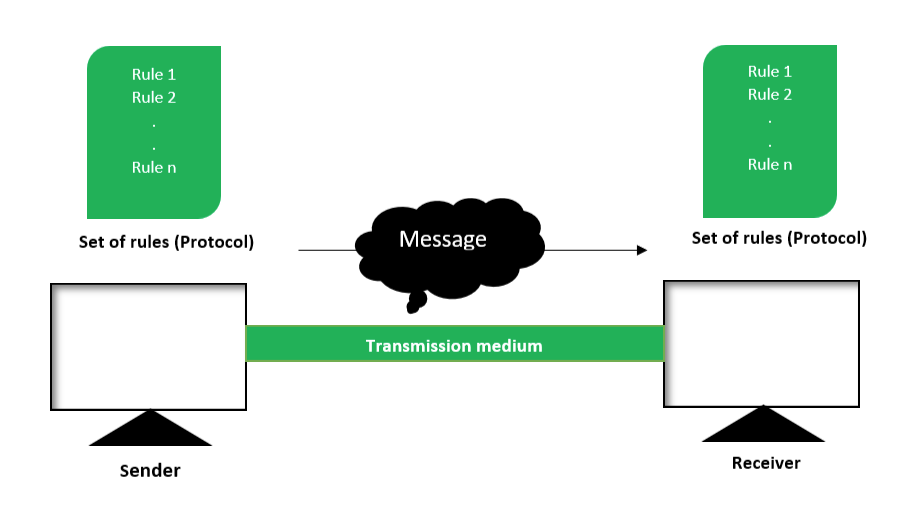1.1 Process of data communication and its components: Transmitter, Receiver, Medium, Message, Protocol
Process of Data Communication:
Data Communication is defined as exchange of data between two devices via some form of transmission media such as a cable, wire or it can be air or vacuum also. For occurrence of data communication, communicating devices must be a part of communication system made up of a combination of hardware or software devices and programs.
Data Communication System Components :
There are mainly five components of a data communication system:
- Message : Message is the information to be communicated by the sender to the receiver.
- Sender : The sender is any device that is capable of sending the data (message).
- Receiver : The receiver is a device that the sender wants to communicate the data (message).
- Transmission Medium : It is the path by which the message travels from sender to receiver. It can be wired or wireless and many subtypes in both
- Protocol :It is an agreed upon set or rules used by the sender and receiver to communicate data A protocol is a set of rules that governs data communication.
All above mentioned elements are described below:

- Message :
This is most useful asset of a data communication system. The message simply refers to data or piece of information which is to be communicated. A message could be in any form, it may be in form of a text file, an audio file, a video file, etc. - Sender :To transfer message from source to destination, someone must be there who will play role of a source. Sender plays part of a source in data communication system. It is simple a device that sends data message. The device could be in form of a computer, mobile, telephone, laptop, video camera, or a workstation, etc.
- Receiver :
It is destination where finally message sent by source has arrived. It is a device that receives message. Same as sender, receiver can also be in form of a computer, telephone mobile, workstation, etc. - Transmission Medium :
In entire process of data communication, there must be something which could act as a bridge between sender and receiver, Transmission medium plays that part. It is physical path by which data or message travels from sender to receiver. Transmission medium could be guided (with wires) or unguided (without wires), for example, twisted pair cable, fiber optic cable, radio waves, microwaves, etc. - Set of rules (Protocol) :
To govern data communications, various sets of rules had been already designed by the designers of the communication systems, which represent a kind of agreement between communicating devices. These are defined as protocol. In simple terms, the protocol is a set of rules that govern data communication. If two different devices are connected but there is no protocol among them, there would not be any kind of communication between those two devices. Thus the protocol is necessary for data communication to take place.
A typical example of a data communication system is sending an e-mail. The user which send email act as sender, message is data which user wants to send, receiver is one whom user wants to send message, there are many protocols involved in this entire process, one of them is Simple Mail Transfer Protocol (SMTP), both sender and receiver must have an internet connection which uses a wireless medium to send and receive email.
Comments
Post a Comment